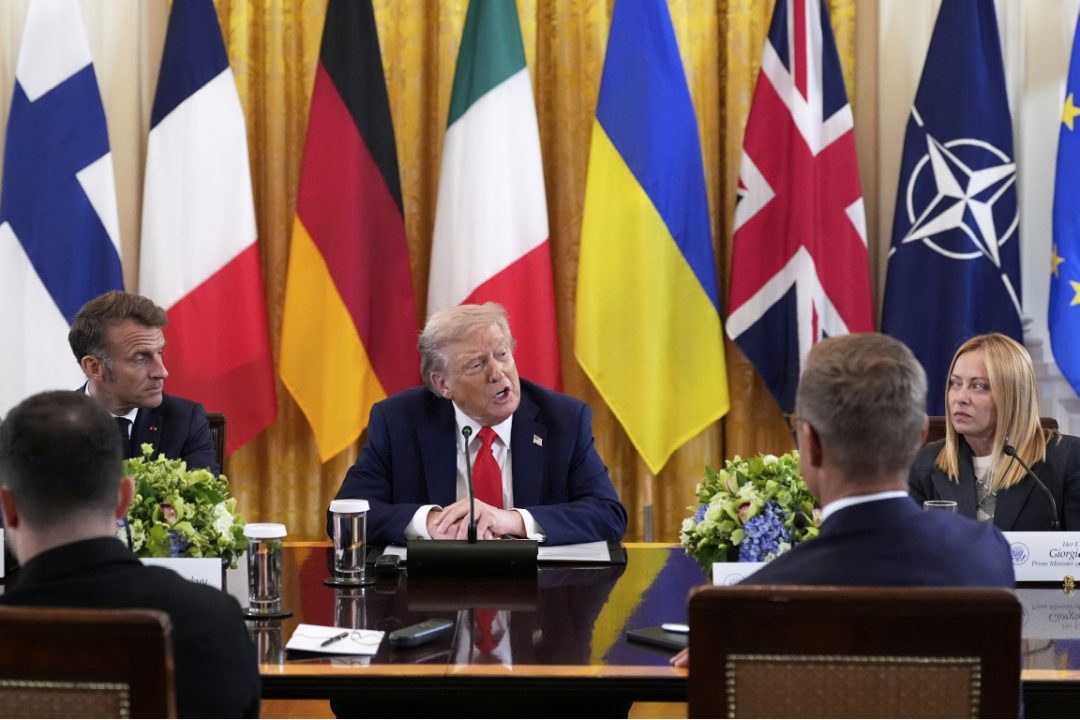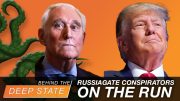
A slew of European leaders converged on Washington, D.C., Monday to meet with President Donald Trump. The meeting follows Trump’s summit with Russian President Vladimir Putin in Alaska on Friday, which appears to have prompted a few shifts in Trump’s thinking, some of which the Europeans undoubtedly want to reverse.
The three major topics that came up were security guarantees for Ukraine, territorial concessions, and ceasefires. These are the items that Ukraine and Russia need to agree on if there is to be a peace deal.
Before his private meeting with Ukrainian President Volodymyr Zelensky and several European leaders, Trump held a White House press meeting with just him and the Ukrainian president. Unlike in February, there was no berating. The two were very cordial to each other. Zelensky even dressed up for the occasion. He wore a buttoned black shirt with a black jacket.
The other Europeans who attended the meetings included the heads of the United Kingdom, Germany, France, Italy, Finland, as well as the leaders of the North Atlantic Treaty Organization (NATO) and the European Commission. Trump’s entourage included Vice President JD Vance, Chief of Staff Susie Wiles, Secretary of State Marco Rubio, Defense Secretary Pete Hegseth, and Treasury Secretary Scott Bessent.
Long-term Security
Zelensky and the Europeans have and continue to insist on “security guarantees” for Ukraine with a “U.S. backstop.” In other words, they want U.S. troops stationed in Ukraine. Over the last few months, Trump has been a little inconsistent on this issue, but he’s largely taken a noncommittal position that leans more in the direction that Europeans should be protecting Europe. Monday was no different. A reporter asked Trump is he’s willing to send American “peacekeepers” to Ukraine. Trump’s response:
We’re going to work with Ukraine, we’re going to work with everybody, we’re going to make sure that if there’s peace, the peace is going to stay long-term.… We’re not talking about a two-year peace and then we end up in this mess again.
Because he evaded the question, a reporter asked again: Will security guarantees involve U.S. troops? Trump:
When it comes to security, there’ll be a lot of help. Europe is the first line of defense, because they’re there, but we’ll help them out.
When all the leaders were seated around Trump, he downplayed the notion of future Russian aggression, a major stated concern among the Europeans. Trump said:
I’m optimistic that we can collectively reach an agreement to deter any future aggression against Ukraine, and actually I think there won’t be. I think that’s even overrated — largely overrated. But we’re going to find out.
A reporter asked Zelensky if the security guarantees he wants include U.S. troops, intelligence, or equipment. He replied, “Everything.”
Trump also claimed that Putin agreed to accept security guarantees during his visit in Alaska.
No NATO
Ingrained in the security issue is NATO. Trump appears to have emerged from his rendezvous with Putin solidly convinced that Ukrainian admittance into NATO is off the table. Sunday night, he posted on his Truth Social account:
President Zelenskyy of Ukraine can end the war with Russia almost immediately, if he wants to, or he can continue to fight. Remember how it started. No getting back Obama given Crimea (12 years ago, without a shot being fired!), and NO GOING INTO NATO BY UKRAINE. Some things never change!!!
Ukraine’s steps over the last few years toward NATO membership is the primary reason Russia cites for its invasion. Putin dedicated the bulk of his speech on the eve of the invasion to explaining how the West had deceived the Russians about NATO’s eastward expansion. On Monday, NATO came up again, and this time, Trump repeated a line that surely made the Kremlin happy. Trump said, “Long before Putin, there was always a statement that they weren’t going to allow Ukraine into NATO.” You can read more on this in our previous reporting here.
Ceasefires
Trump has also changed his mind on ceasefires. Before Friday, he said he would work to convince Putin to agree to a ceasefire. Trump threatened to impose “severe consequences” if Russia didn’t oblige. But, to the Europeans’ chagrin, Trump has a new, more Putin-friendly, perspective. He said:
I know that [a ceasefire] might be good to have, but I can understand, strategically, why one country, or the other one, wouldn’t want it. You have a ceasefire and they rebuild and rebuild — and you know, maybe they don’t want that.… But strategically, that can be a disadvantage for one side or the other.
This is the Kremlin’s position. The Russians claim that Ukraine and the Europeans are asking for a ceasefire to rest, rearm, and — in the case of the Europeans — have more time to prepare to jump in the fight. Ukraine is on its back. It is suffering a significant manpower problem, and Russian troops have made major gains over the last few weeks, especially in in the Donetsk region. A break in fighting would indeed benefit them.
Trump has also defended his shift by pointing to other peace deals he has mediated this year that did not include a ceasefire. Nevertheless, it’s clear the Europeans will try to get Trump to reverse his thinking on this matter. Before heading to their closed-doors meeting, German Chancellor Friedrich Merz said, “We’d like to see a ceasefire. I can’t imagine that the next meeting would take place without a ceasefire. So let’s work on that, let’s try to put pressure on Russia.”
Territory Talks
Territorial concessions also came up.
Fox News reporter Peter Doocy asked Zelensky if he was willing to keep “sending Ukrainian men to their deaths” or if he was ready to “redraw maps.” Zelensky evaded the question. “We live under each day attacks,” he began answering, before continuing on in that vein.
Up until a few days ago, Zelensky dismissed any notion of giving up Ukrainian land, even territory under Russian control. But last week, he began to waver. After meeting with European leaders, Merz announced that Zelensky was ready to discuss territory, but stipulated that the starting point for any negotiations must be the current battle-line. He reiterated his position before Monday’s meeting with Trump, when he told reporters that “while Kyiv would be open to ‘land swaps’ in exchange for peace, Putin’s demands to cede the entirety of the Donetsk region — including parts under Ukrainian control — is off the table,” according to reports . Zelensky also said, “We need real negotiations, which means they can start where the front line is now. The contact line is the best line for talking.”
Trump echoed his support for “land swapping,” as he called it some days back. He said Monday, “We also need to discuss the possible exchange of territory taken into consideration.” Like Zelensky, he said the “line of contact,” the regions where the fighting is happening, is the place to start talking about new boundaries. Russia controls the eastern territory of Ukraine in addition to Crimea.
Elections and Lasting Peace
One reporter also asked Zelensky if Ukraine will have elections should a peace deal be struck. Ukraine has not had its scheduled elections, for president or its Parliament, as a result of the martial-law status that was decreed after the Russian invasion. Zelensky told the reporter, “Yes, of course, we are open to election.”
Some of the Europeans praised Trump for bringing peace talks further than at any point since the war started. They all expressed a desire for lasting peace. Whether they are genuine in that desire will likely become more evident in the coming days.





